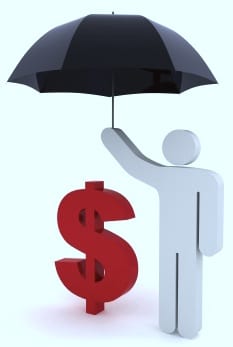
Lana Joseph, M.S.
This week’s post reports on the results of a short, informal survey conducted by Lana M. Joseph, M.S. that sought to determine, in part, some options hearing aid offices offer to manage security and protection for their patients’ hearing aids. She received her Master’s degree in Health Care Management from the University of New Orleans. She realizes that in no way is this survey being presented as conclusive evidence. Instead, it takes an idea that was generated, roughly surveyed, data collected, and reported. The intent in this post was to pull out salient information, and pointing out how the data collection could have been improved. HHTM thanks Lana Joseph for allowing HHTM to use data she has collected to provide some interesting survey results. Wayne Staab, Editor
Some Hearing Instrument Protection Options Underutilized by Dispensers
Background
This short, informal survey was conducted to investigate the types of hearing instrument protection options offered by individuals dispensing hearing aids, specifically those related to hearing aid care, repair, and replacement of lost instruments. The survey was submitted to a group of 55 professionals within the hearing industry, including hearing instrument specialists, audiologists, and hearing aid practice owners.
The issue of interest related to the actual security and protection opportunities available to help reduce the number of repair appointments necessary by managing the longevity, continued quality, and concern of lost hearing aids. Some options are designed specifically to protect the hearing device from moisture, whistling, skin irritation, wind noise, dirt, and loss or damage. It is thought that minimizing any of these concerns should result in increased user satisfaction.
The questions below were presented to all of the 55 hearing professionals. For some questions, respondents were allowed just a single answer, while on others they were allowed to provide multiple responses. All questions were closed-set, meaning that there were no options for alternate responses. In a few cases, respondents provided no answer. The questions relative to hearing aids dispensed and the number of patients seen were asked to obtain baseline information. The questions were:
- How many patients are seen in your office on an average day?
- How many hearing aids do you dispense in an average month?
- How many hearing aid appointments in a one-month period are utilized to assist patients with damage due to sweat/moisture or dirt, skin irritation, wind noise/whistling, or lost hearing aids?
- What products or services do you provide to help your patients deal with damage due to sweat/moisture or dirt, skin irritation, wind noise/whistling, or lost hearing aids?
- What products or services do you provide to help your patients for hearing aids that are lost?
- What percentage of your patients purchase private hearing aid insurance policies?
- What is the average yearly cost to your clients for private hearing aid insurance policies?
Survey Results of Hearing Aid Protective Practices
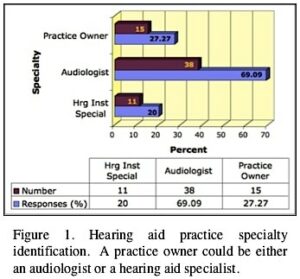 In all graphics that follow, the percent responses are shown in blue bars. The maroon bars indicate the number of respondents answering the question. Percentages are rounded to the nearest whole number in the text, although the graphics report the actual percentages.
In all graphics that follow, the percent responses are shown in blue bars. The maroon bars indicate the number of respondents answering the question. Percentages are rounded to the nearest whole number in the text, although the graphics report the actual percentages.
Respondent Backgrounds
Respondent breakdown is shown in Figure 1. Most respondents were audiologists. The specialty option of practice ownership, which was not defined, resulted in this being a less meaningful breakdown of the types of practices involved. The owner could be either an audiologist or a hearing aid specialist, but regardless of the breakdown, most respondents would still be audiologists.
Number of Patients Seen Daily
Forty-five percent of hearing professionals surveyed reported seeing an average of 6-10 patients at their office per day (Figure 2). Twenty-two percent reported 11-15, and 15% reported over 15 patients per day.
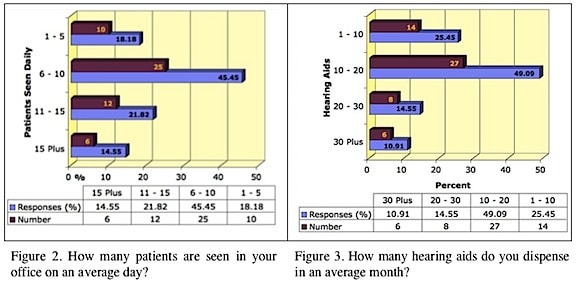
Number of Hearing Aids Sold Per Month
Almost half of the hearing professionals reported dispensing an average of 10-20 hearing aids per month (Figure 3). Approximately 15% reported dispensing 20-30, and roughly, 11% reported over 30 hearing aids per month. Of interest is that 25% sold fewer than 10 hearing aids per month.
Service Appointments Per Month
This survey was intended primarily to determine what options hearing professionals make available to either prepare for or manage the impact of hearing aid repairs or lost products. Hearing professionals reported the number and percentages of service appointments per month to assist patients with repairs due to moisture/sweat, whistling/wind noise, or lost hearing aids and is shown in Figure 4. Because these data were not correlated with the number of hearing aids sold on average per month, all that can be reported is that for the respondents overall, the average number of service appointments per month was 14.
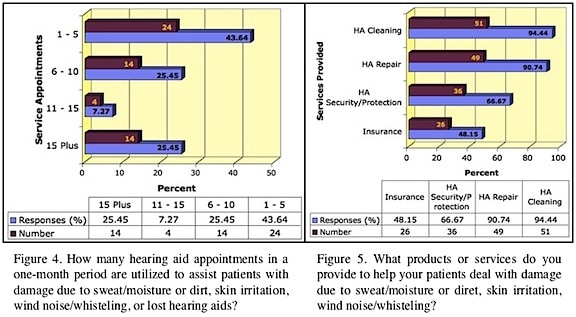
Repair Services Provided
Figure 5 shows the major services provided to help patients deal with hearing aid damage due to sweat/moisture or dirt, skin irritation, wind noise/whistling or lost hearing aids. This question allowed for multiple answers. On the first two, hearing aid cleaning and hearing aid repair, less than 100% responded that they engaged in these practices. Why some dispensers failed to report providing these two vital services for their patients is curious.
The category of hearing aid security/protection related to any device, accessory, or option used to protect the hearing aid from damage due to sweat/moisture or dirt, skin irritation, wind noise/whistling, or loss. About 67% responded that they offered something in this category. However, data relative to the specific protection device/plan, or how often something was purchased or used, would have provided more meaningful information.
Lost hearing aid protection plan
When a hearing aid is lost, or to prevent loss, respondents were asked to select what they offer their patients from the categories identified in Figure 6. Again, this question allowed for multiple answers.
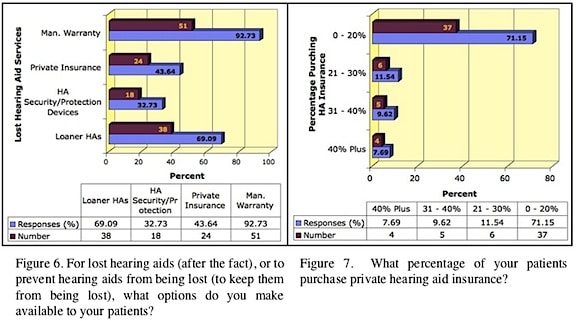
It appears that most dispensers rely on the manufacturer’s warranty for lost hearing aids. This generally involves a single claim on an instrument, along with some kind of co-pay for replacement. About 70% offer a loaner hearing aid during the lost period, and 44% make available some kind of private insurance policy that covers a lost instrument.
Figure 6 shows also that only 33% indicated they offer some protective device or accessory to prevent loss, suggesting that this option may be vastly underutilized. These could be options that attach the aid(s) to the user to prevent a lost hearing aid, or other such device/accessory that prevents hearing aid loss. However, merely stating that this option is available would have been enhanced with a number estimating the actual time such a device or accessory was purchased by patients. There could be a large disconnect between offering something and that selling it.
Percent Patients Sold Private Insurance
Figure 7 provides data as to how often private hearing aid insurance is purchased. The data suggests that most dispensers (71%) sell private insurance to 20% or fewer of their patients. However, because of the way the question was worded, it’s possible that these 71% sold did not sell private insurance to any of their patients. This question was different from most others because it actually asked for a purchased number, rather than just an offered number.
 Private insurance cost per year
Private insurance cost per year
Fifty-nine percent of respondents indicated that the cost per unit per year for private insurance is $75 or greater (Figure 8). Twenty-three percent indicate a cost of less than $25 per year per unit. Again, this could mean that 10 people could have had no yearly cost for insurance. Likewise, what does the $75/year plus figure represent? Could this be $100, $200, or any other higher number? The answer is in the affirmative. (No attempt was made to determine what kind of coverage these costs represented. One has to ask also, what kind of insurance it is that costs less than $25 or $50/year).
Summary
The results of this short survey offer some general insights into the hearing aid protective practices offered to patients for preventing and managing malfunctioning and lost hearing aids. In retrospect, the data would have been more useful if the number had related to how many dispensers offered a service to manage sweat/moisture or dirt, skin irritation, wind noise/whistling or lost hearing aids, against the actual number of persons who purchased the offerings. Still, it provides some interesting information, showing that only a small percentage of professionals sell a private insurance policy against lost hearing aids (30%). And while it appears that a fairly high percentage of dispensers (67%, Figure 5) say they offer some kind of hearing aid security/protection to that hearing aid other than private insurance, only 32% (Figure 6) report using such devices to manage security/protection of hearing aids purchased.



